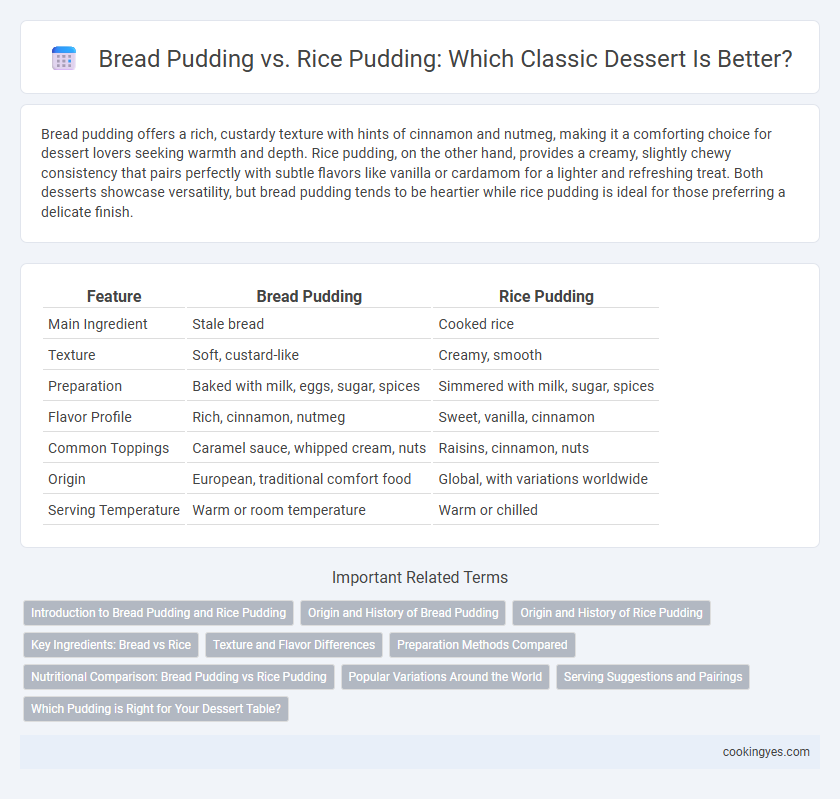Bread pudding offers a rich, custardy texture with hints of cinnamon and nutmeg, making it a comforting choice for dessert lovers seeking warmth and depth. Rice pudding, on the other hand, provides a creamy, slightly chewy consistency that pairs perfectly with subtle flavors like vanilla or cardamom for a lighter and refreshing treat. Both desserts showcase versatility, but bread pudding tends to be heartier while rice pudding is ideal for those preferring a delicate finish.
Table of Comparison
| Feature | Bread Pudding | Rice Pudding |
|---|---|---|
| Main Ingredient | Stale bread | Cooked rice |
| Texture | Soft, custard-like | Creamy, smooth |
| Preparation | Baked with milk, eggs, sugar, spices | Simmered with milk, sugar, spices |
| Flavor Profile | Rich, cinnamon, nutmeg | Sweet, vanilla, cinnamon |
| Common Toppings | Caramel sauce, whipped cream, nuts | Raisins, cinnamon, nuts |
| Origin | European, traditional comfort food | Global, with variations worldwide |
| Serving Temperature | Warm or room temperature | Warm or chilled |
Introduction to Bread Pudding and Rice Pudding
Bread pudding and rice pudding are classic comfort desserts with distinct textures and flavors. Bread pudding uses cubed bread soaked in a rich custard mixture, often enhanced with spices like cinnamon and nutmeg, while rice pudding features creamy, slow-cooked rice infused with milk and sugar, sometimes flavored with vanilla or cardamom. Both desserts offer versatile bases for adding fruits, nuts, or sauces, making them beloved choices for warm, satisfying sweets.
Origin and History of Bread Pudding
Bread pudding originated in medieval Europe as a frugal dessert designed to utilize stale bread, combining it with milk, eggs, and sugar to create a rich custard. Historical records trace its popularity to England in the 11th century, where it was known as "poor man's pudding" due to its inexpensive ingredients. This traditional dish evolved over centuries, spreading to North America and other regions, adapting to local tastes while maintaining its roots in resourceful cooking.
Origin and History of Rice Pudding
Rice pudding traces its origins to ancient civilizations in Asia, particularly India and China, where rice was a staple crop and sweetened rice dishes became popular desserts. This creamy dish spread along trade routes, evolving into various regional recipes that incorporate local spices and ingredients like cardamom and saffron. Unlike bread pudding, which emerged in Europe as a way to use stale bread, rice pudding has a longer history rooted in agricultural societies dependent on rice cultivation.
Key Ingredients: Bread vs Rice
Bread pudding relies on stale bread soaked in a mixture of milk, eggs, sugar, and spices, creating a custard-like texture that absorbs flavors deeply. Rice pudding features cooked rice simmered in milk or cream with sugar and often enriched with vanilla or cinnamon, resulting in a creamy, grainy dessert. The choice between bread and rice as the base significantly affects texture and flavor profile, with bread offering a denser, cake-like consistency and rice providing a softer, smoother bite.
Texture and Flavor Differences
Bread pudding features a dense, custard-soaked texture with a rich, buttery flavor enhanced by cinnamon and nutmeg spices, while rice pudding offers a creamy, smooth consistency with a subtly sweet taste often infused with vanilla or cardamom. Bread pudding's chewy bread pieces contrast with rice pudding's tender, individual grains, creating distinct mouthfeel experiences. Flavor intensity in bread pudding leans toward warm spices and caramelized edges, whereas rice pudding highlights delicate dairy sweetness and gentle aromatic notes.
Preparation Methods Compared
Bread pudding preparation involves soaking stale bread pieces in a custard mixture of eggs, milk, sugar, and spices before baking until golden and set. Rice pudding requires cooking rice slowly in milk or cream, with sugar and flavorings like cinnamon or vanilla, either on the stovetop or in the oven until creamy and tender. The key difference lies in bread pudding's use of bread absorbing the custard and baking solid, while rice pudding's rice grains cook directly in the liquid, creating a softer, creamier texture.
Nutritional Comparison: Bread Pudding vs Rice Pudding
Bread pudding typically contains higher calories and fat due to butter and eggs, while rice pudding offers more carbohydrates and can be lower in fat if made with skim milk. Protein content is generally similar, but rice pudding may provide more calcium from dairy ingredients. Both desserts vary in sugar levels depending on added sweeteners, making portion control important for balanced nutrition.
Popular Variations Around the World
Bread pudding features popular variations such as British bread and butter pudding, French pain perdu, and South African melktert, each incorporating local spices and custards. Rice pudding showcases diverse styles like Indian kheer, Middle Eastern muhallabia, and Scandinavian risalamande, often flavored with cardamom, rose water, or almonds. Both desserts reflect regional ingredients and culinary traditions, making them beloved sweet treats worldwide.
Serving Suggestions and Pairings
Bread pudding pairs exceptionally well with warm caramel sauce or a drizzle of bourbon glaze, enhancing its rich, custardy texture, often served with a side of vanilla ice cream for added creaminess. Rice pudding complements fresh fruit toppings like mango or berries, and a sprinkle of cinnamon or nutmeg, creating a lighter, refreshing dessert experience. Both desserts benefit from a dusting of powdered sugar and a hot beverage such as chai tea or coffee to balance their sweetness.
Which Pudding is Right for Your Dessert Table?
Bread pudding offers a rich, custard-soaked texture with hints of cinnamon and vanilla, making it ideal for those who prefer a warm, comforting dessert. Rice pudding features a creamy consistency with subtle sweetness, perfect for guests seeking a lighter, dairy-based option. Choose based on your dessert table's theme: bread pudding for hearty, spiced flavors or rice pudding for a smooth, delicate finish.
Bread Pudding vs Rice Pudding for Dessert Infographic

 cookingyes.com
cookingyes.com